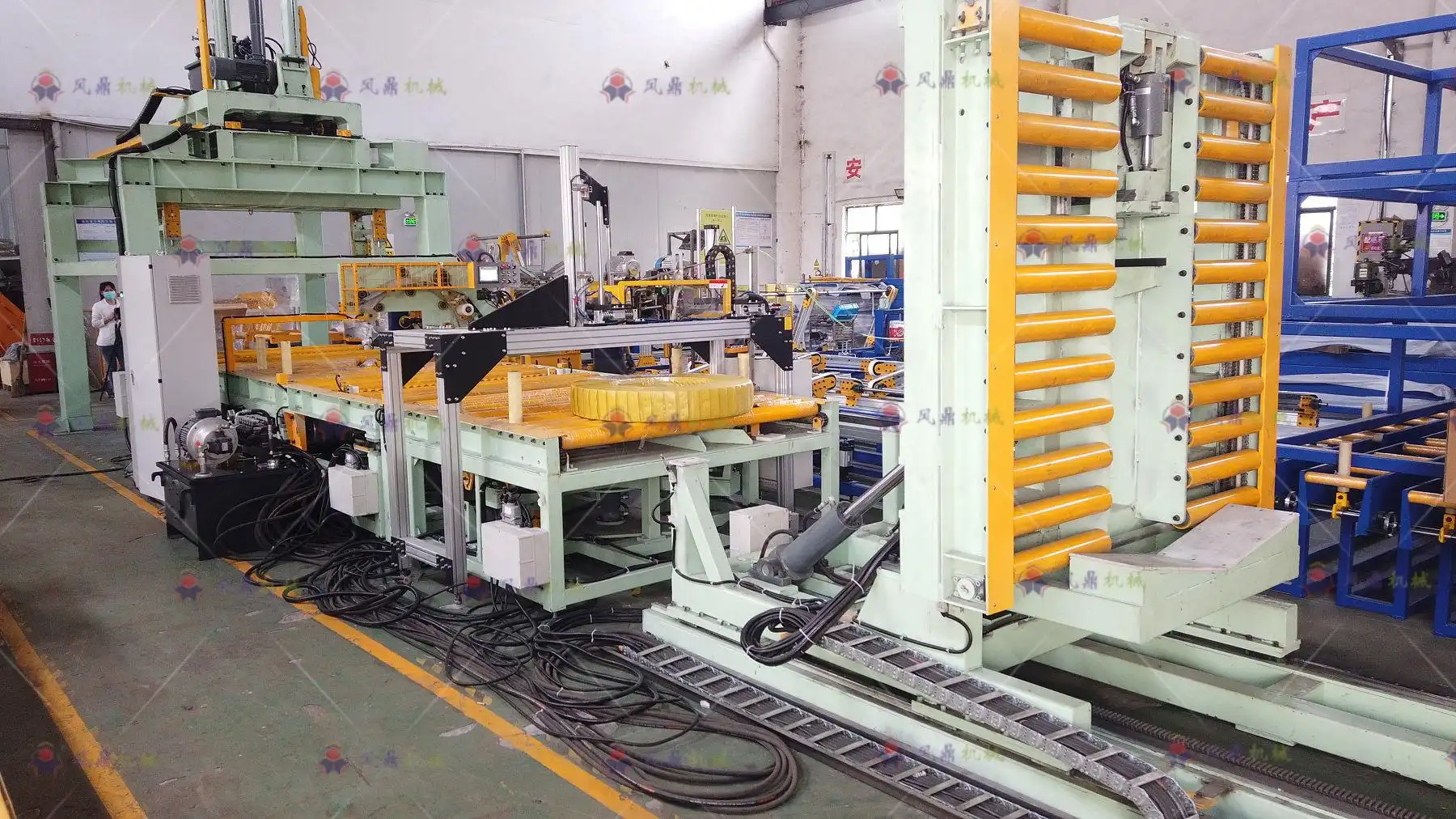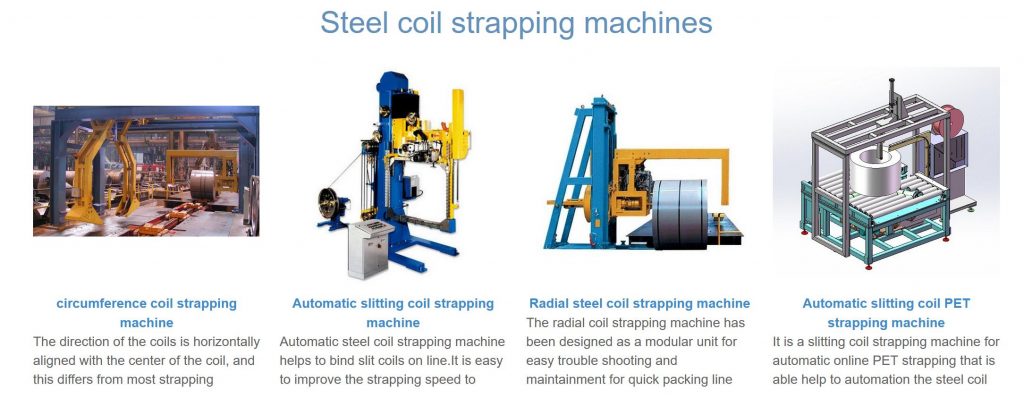Understanding Steel Strip Coil Strapping Machines: Features and Automation
Automated strapping solutions are crucial in modern manufacturing environments dealing with steel coils, wire coils, and similar products. Efficiently bundling and securing these heavy items ensures package integrity, facilitates handling, and improves overall operational workflow. This guide explores the features and considerations of automated coil strapping machines.
The video above demonstrates an example of a steel strip coil strapping machine utilizing PET (Polyester) strapping.
1. The Need for Automated Coil Strapping
In many production facilities, coils are produced automatically but then require manual strapping. This manual process often involves:
- Handling heavy individual coils (e.g., 50 lbs or 22.7 kg).
- Stacking multiple coils to create a master pack (e.g., 10 coils for a 500 lbs or 227 kg bundle).
- Manually applying multiple straps (commonly steel or PET) around and potentially through the eye of the coil bundle.
This manual approach can be labor-intensive, time-consuming, and may lead to inconsistencies in strap tension and placement. Automated strapping machines address these challenges by streamlining the process.
2. Key Components and Features of Automated Coil Strapping Systems
Modern coil strapping machines integrate several key components to provide efficient and reliable operation:
2.1 Coil Handling and Loading
- Loading Station: Designed to receive and position individual coils or pre-stacked bundles accurately for the strapping process. This can range from simple manual placement onto a conveyor to fully automated robotic loading.
- Alignment: Mechanisms ensure the coil bundle is correctly positioned relative to the strapping head, especially for through-the-eye strapping.

steel coil packaging line4 2.2 Strapping Head and Arch
- Strapping Head: The core component that feeds, tensions, seals, and cuts the strap. It's designed for specific strap types (steel or PET/PP).
- Arch: Guides the strap around the coil bundle. For strapping through the coil's eye, a specialized lance or arch mechanism penetrates the center opening before guiding the strap.
2.3 Strap Feed, Tensioning, and Sealing
- Strap Dispenser: Holds large coils of strapping material (e.g., Polyester Smooth Green PSAAR .035 x .625 x 4000ft).
- Auto-Tensioning: Ensures consistent strap tightness for secure bundling, adjustable based on product requirements.
- Sealing Unit: Joins the strap ends. Common methods include heat sealing (for PET/PP) or mechanical seals/crimps (for steel). Effective sealing prevents strap slippage.
2.4 Control System
- PLC (Programmable Logic Controller): Automates the entire sequence – strap feeding, arch movement, tensioning, sealing, and cutting. Allows operators to preset parameters like the number of straps, tension levels, and strapping positions.
- HMI (Human-Machine Interface): Provides an interface for operators to monitor the process, adjust settings, and troubleshoot issues.
2.5 Unloading Station
- Discharges the fully strapped coil bundle, often onto a conveyor or designated area for pickup.
3. Strapping Material Considerations
While the video shows PET strapping, both PET and steel strapping are common for coils:
- PET (Polyester) Strapping: Offers high tensile strength, resistance to environmental factors, and better elongation and recovery than PP (Polypropylene). It's often safer to handle than steel.
- Steel Strapping: Provides maximum strength and rigidity, essential for very heavy or sharp-edged loads. Requires specialized sealing methods (notch or seal crimps).
The choice depends on the coil weight, handling requirements, and desired load stability.

4. Automation Levels and Integration
Automated strapping solutions can vary in complexity:
- Standalone Machines: Require manual loading and unloading but automate the strapping cycle itself.
- Semi-Integrated Systems: May incorporate conveyors for loading/unloading but still operate somewhat independently.
- Fully Integrated Lines: Combine strapping with other processes like coil forming, weighing, labeling, and robotic handling for a seamless production flow from start to finish. Manufacturers can often provide integration capabilities, including robotics, to place coils into the machine for higher automation levels.
5. Safety and Design
Given the weights involved (up to 500 lbs / 227 kg or more per bundle) and the automated movements:
- Robust Construction: The machine frame and components must be built to withstand industrial use and heavy loads.
- Safety Guarding: Physical barriers, light curtains, and emergency stops are essential to protect operators from moving parts, pinch points, and potential hazards during strap tensioning or sealing (e.g., heat from sealing elements). Adherence to safety standards like those from OSHA or equivalent bodies is critical.
6. Benefits of Automated Coil Strapping
Implementing an automated steel or PET strip coil strapping machine offers significant advantages:
- Increased Throughput: Faster cycle times compared to manual strapping.
- Improved Consistency: Uniform strap placement and tension ensure reliable package security.
- Reduced Labor Costs: Frees up personnel from repetitive manual tasks.
- Enhanced Safety: Minimizes manual handling of heavy coils and strapping tools.
- Optimized Material Usage: Precise tensioning can potentially reduce strap consumption.
Conclusion
Automated steel strip coil strapping machines, whether using steel or PET strap, are vital for improving efficiency, safety, and consistency in coil packaging operations. By automating the feeding, tensioning, sealing, and cutting process, manufacturers can handle high production volumes effectively. When selecting a system, factors like coil dimensions, weight, required throughput, strapping material, and desired level of automation are key considerations for a tailored solution that meets specific operational needs.